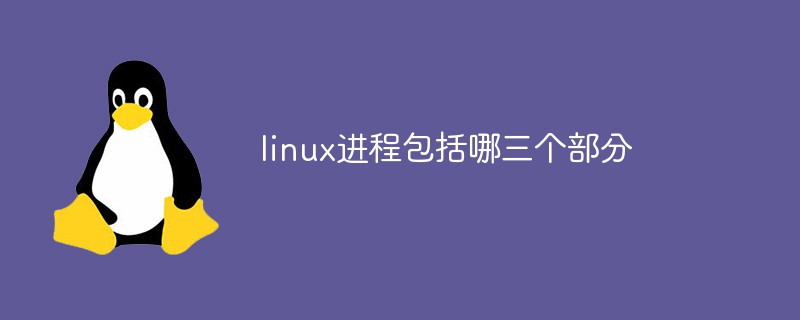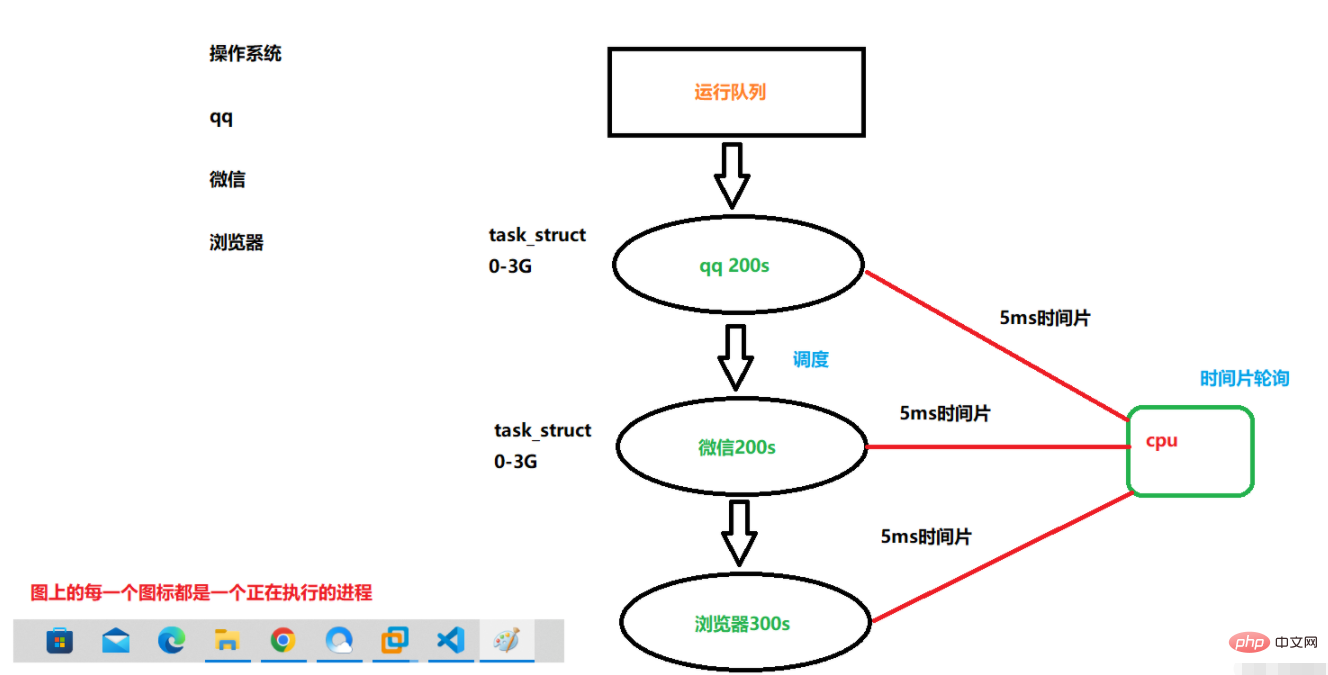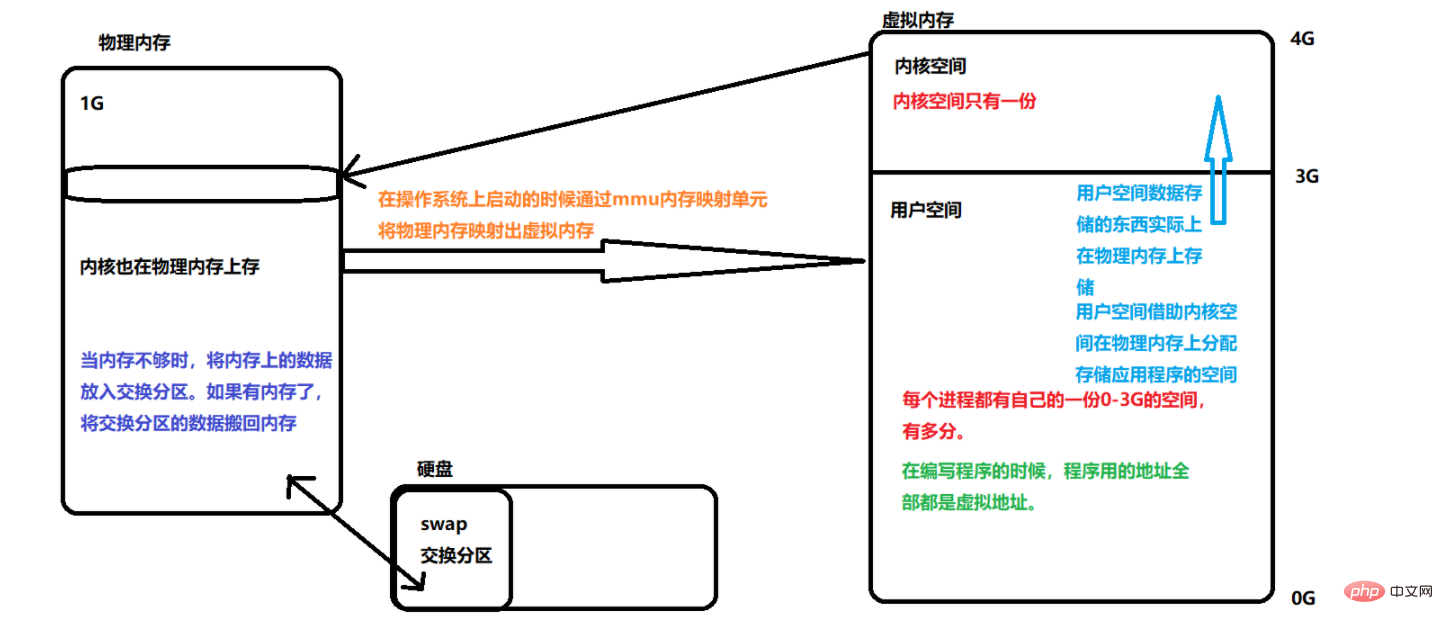 Operation and Maintenance
Operation and Maintenance
 Linux Operation and Maintenance
Linux Operation and Maintenance
 What three parts does the linux process include?
What three parts does the linux process include?
What three parts does the linux process include?
The three parts of the Linux process: 1. The process control block makes a program (including data) that cannot run independently in a multi-program environment become a basic unit that can run independently, and can be combined with other Processes that are executed concurrently; 2. Program segment is the program code segment in the process that can be executed by the process scheduler on the CPU; 3. Data segment is the data segment of a process, which can be the original processed by the program corresponding to the process. Data can also be intermediate or final data generated after program execution.

#The operating environment of this tutorial: linux7.3 system, Dell G3 computer.
1. Definition of process
A process (Process) is a program in the computer that performs a running activity on a certain data collection. It is a system The basic unit for resource allocation is the basis of the operating system structure.
In short, it is the execution process of program.
A process is an instance of a running program, that is, a task that is being executed.
The process has a life cycle. It is created as the program runs and terminates as the program ends.
The process is the smallest unit for allocating resources. As long as a process is created, [0-3G] of user space is allocated.
As long as the user executes a program, the kernel will create a task_struct (PCB) structure, which represents the current process.
Maintains its own set of file descriptors and buffers within the process. As soon as the process execution ends, all its resources will be reclaimed by the operating system.

Time slice polling to achieve concurrency

2. Characteristics of the process
Dynamicity: The essence of a process is the execution of a program in a multi-programming system. The process is dynamically generated and dies dynamically.
Concurrency: Any process can execute concurrently with other processes
Independence: A process is a basic unit that can run independently. It is also an independent unit for system resource allocation and scheduling;
Asynchronicity: Due to the mutual constraints between processes, the process has intermittent execution, that is, the processes are independent and unpredictable. Advance at a faster speed
Multiple different processes can contain the same program: a program constitutes different processes in different data sets and can obtain different results; but execution During the process, the program cannot be changed.
3. The composition and function of the process
The composition of the process consists of three parts: process control block PCB (task_struct), data segment , program segment.
Process control block: Make a program (including data) that cannot run independently in a multiprogramming environment become a basic unit that can run independently, and a process that can execute concurrently with other processes.
Program segment: It is the program code segment in the process that can be executed on the CPU by the process scheduler.
Data segment: The data segment of a process can be the original data processed by the program corresponding to the process, or the intermediate or final data generated after the program is executed.
4. Process control block
##4.1 Process control block definition
In order to describe the operation of the control process, the data structure in the system that stores the management and control information of the process is called the process control block (PCB Process Control Block). It is part of the process entity and is a part of the operating system. The most important record-keeping data structure. It is the most important data structure for process management and control. Each process has a PCB. When a process is created, the PCB is established and accompanies the entire process of running the process until the process is cancelled.
The essence of PCB is a structure. The name of PCB is different in different operating systems. In Linux, the PCB is called task_struct, and the PCB is the only means of controlling the process. Each process has a process descriptor. This "process descriptor" is task_struct. A lot of information about process control is stored in task_struct.
- Identifier (pid): The unique identifier that describes this process and is used to distinguish other processes.
- Status: task status, exit code, exit signal, etc.
- Priority: relative to the priority of other processes (the smaller the number, the higher the priority).
- Program counter: The address of the next instruction to be executed in the program.
Memory pointers: including pointers to program code and process-related data, as well as pointers to memory blocks shared with other processes.
Context data: Saving the context is to save the value in the CPU register to the memory; restoring the context is to restore the register value in the memory to the CPU;
I/O status information: includes displayed I/O requests, I/O devices assigned to the process and a list of files being used by the process.
Accounting information: may include the total processor time, the total number of clocks used, time limits, accounting accounts, etc.
Other information
##5. The difference between process and program
- A process is an execution process of a program. It is dynamic, has a life cycle, and is stored in memory.
- The program is static and has no life cycle. Stored on disk, a program is an executable file.
- Processes can more truly describe concurrency, but programs cannot.
- Processes have the ability to create other processes, but programs do not.
- The same program can correspond to multiple processes.
6. The difference between processes and threads
Usually a process can contain several threads, and they can Using the resources owned by the process, in the operating system that introduces threads, the process is usually used as the basic unit for allocating resources, and the thread is used as the basic unit for independent running and independent scheduling. Since threads are smaller than processes, they are basically not With system resources, the overhead for its scheduling will be much smaller, and it can more efficiently increase the degree of concurrent execution among multiple programs in the system.7. Types of processes
There are three types of processes: interactive process, batch process, and daemon process- Interactive process: The interactive process is maintained by the shell and interacts with the user through the shell.
For example, a text editor is an interactive process.
- Batch process: The batch process will be placed in a queue in the kernel and run as the queue runs. Its priority is relatively low.
For example, the process of gcc compiling a program.
- Daemon process: The daemon process is a process running in the background. It starts when the system starts and terminates when the system terminates.
For example, various services on windows.
Linux Video Tutorial"
The above is the detailed content of What three parts does the linux process include?. For more information, please follow other related articles on the PHP Chinese website!

Hot AI Tools

Undresser.AI Undress
AI-powered app for creating realistic nude photos

AI Clothes Remover
Online AI tool for removing clothes from photos.

Undress AI Tool
Undress images for free

Clothoff.io
AI clothes remover

Video Face Swap
Swap faces in any video effortlessly with our completely free AI face swap tool!

Hot Article

Hot Tools

Notepad++7.3.1
Easy-to-use and free code editor

SublimeText3 Chinese version
Chinese version, very easy to use

Zend Studio 13.0.1
Powerful PHP integrated development environment

Dreamweaver CS6
Visual web development tools

SublimeText3 Mac version
God-level code editing software (SublimeText3)

Hot Topics
 What computer configuration is required for vscode
Apr 15, 2025 pm 09:48 PM
What computer configuration is required for vscode
Apr 15, 2025 pm 09:48 PM
VS Code system requirements: Operating system: Windows 10 and above, macOS 10.12 and above, Linux distribution processor: minimum 1.6 GHz, recommended 2.0 GHz and above memory: minimum 512 MB, recommended 4 GB and above storage space: minimum 250 MB, recommended 1 GB and above other requirements: stable network connection, Xorg/Wayland (Linux)
 Linux Architecture: Unveiling the 5 Basic Components
Apr 20, 2025 am 12:04 AM
Linux Architecture: Unveiling the 5 Basic Components
Apr 20, 2025 am 12:04 AM
The five basic components of the Linux system are: 1. Kernel, 2. System library, 3. System utilities, 4. Graphical user interface, 5. Applications. The kernel manages hardware resources, the system library provides precompiled functions, system utilities are used for system management, the GUI provides visual interaction, and applications use these components to implement functions.
 vscode terminal usage tutorial
Apr 15, 2025 pm 10:09 PM
vscode terminal usage tutorial
Apr 15, 2025 pm 10:09 PM
vscode built-in terminal is a development tool that allows running commands and scripts within the editor to simplify the development process. How to use vscode terminal: Open the terminal with the shortcut key (Ctrl/Cmd). Enter a command or run the script. Use hotkeys (such as Ctrl L to clear the terminal). Change the working directory (such as the cd command). Advanced features include debug mode, automatic code snippet completion, and interactive command history.
 How to check the warehouse address of git
Apr 17, 2025 pm 01:54 PM
How to check the warehouse address of git
Apr 17, 2025 pm 01:54 PM
To view the Git repository address, perform the following steps: 1. Open the command line and navigate to the repository directory; 2. Run the "git remote -v" command; 3. View the repository name in the output and its corresponding address.
 How to run java code in notepad
Apr 16, 2025 pm 07:39 PM
How to run java code in notepad
Apr 16, 2025 pm 07:39 PM
Although Notepad cannot run Java code directly, it can be achieved by using other tools: using the command line compiler (javac) to generate a bytecode file (filename.class). Use the Java interpreter (java) to interpret bytecode, execute the code, and output the result.
 Where to write code in vscode
Apr 15, 2025 pm 09:54 PM
Where to write code in vscode
Apr 15, 2025 pm 09:54 PM
Writing code in Visual Studio Code (VSCode) is simple and easy to use. Just install VSCode, create a project, select a language, create a file, write code, save and run it. The advantages of VSCode include cross-platform, free and open source, powerful features, rich extensions, and lightweight and fast.
 What is the main purpose of Linux?
Apr 16, 2025 am 12:19 AM
What is the main purpose of Linux?
Apr 16, 2025 am 12:19 AM
The main uses of Linux include: 1. Server operating system, 2. Embedded system, 3. Desktop operating system, 4. Development and testing environment. Linux excels in these areas, providing stability, security and efficient development tools.
 vscode terminal command cannot be used
Apr 15, 2025 pm 10:03 PM
vscode terminal command cannot be used
Apr 15, 2025 pm 10:03 PM
Causes and solutions for the VS Code terminal commands not available: The necessary tools are not installed (Windows: WSL; macOS: Xcode command line tools) Path configuration is wrong (add executable files to PATH environment variables) Permission issues (run VS Code as administrator) Firewall or proxy restrictions (check settings, unrestrictions) Terminal settings are incorrect (enable use of external terminals) VS Code installation is corrupt (reinstall or update) Terminal configuration is incompatible (try different terminal types or commands) Specific environment variables are missing (set necessary environment variables)





